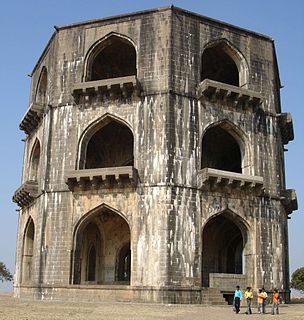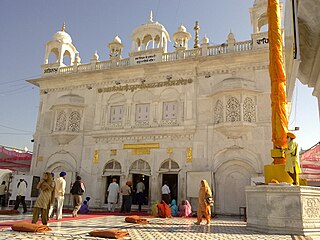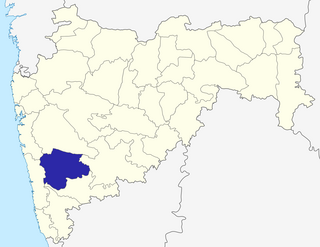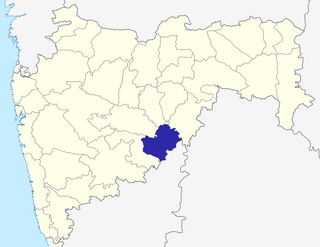
Ahmednagar is a city in Ahmednagar district in the state of Maharashtra, India, about 120 km northeast of Pune and 114 km from Aurangabad. Ahmednagar takes its name from Ahmad Nizam Shah I, who founded the town in 1494 on the site of a battlefield where he won a battle against superior Bahamani forces. It was close to the site of the village of Bhingar. With the breakup of the Bahmani Sultanate, Ahmad established a new sultanate in Ahmednagar, also known as Nizam Shahi dynasty.

Aurangabad is a city in the Aurangabad district of Maharashtra state in India. Aurangabad is also the administrative capital of the centrally situated Marathwada region. The city is an important industrial hub, as well as a tourism hub, and is surrounded by several historical monuments and the UNESCO World Heritage Sites such as the Ajanta and Ellora caves.

Nanded is a city in Maharashtra state, India. It is the eighth largest urban agglomeration of the state and the seventy-ninth most populous city in India. It is the second largest city in Marathwada subdivision. Nanded is the centre of governance of Nanded district. Nanded is a major destination for Sikh pilgrims, because the 10th Sikh Guru made Nanded his permanent abode and passed his guruship to the Guru Granth Sahib before his death in 1708.
Osmanabad district is an administrative district in the Marathwada region in the Indian state of Maharashtra.The district headquarter is located at Osmanabad. This primarily rural district occupies an area of 7569 km² of which 241.4 km² is urban and has a population of 1,660,311 of which 16.96% were urban.
Pune is a district in the state of Maharashtra, India. Pune City Central is the District Headquarters. The district's population was 9,426,959 in the 2011 census, the fourth-most-populous of India's 640 districts. Its urban population is 58.08 percent of its total population; the population of the Pune urban area is over five million.

Satara district is a district of Maharashtra state in western India with an area of 10,480 km² and a population of 3,003,741 of which 14.17% were urban. Satara is the capital of the district and other major towns include Wai, Karad, ,Koregaon, Dahiwadi, Koynanagar, Rahimatpur, Phaltan, Mahabaleshwar, Vaduj and Panchgani. This district comes under Pune Administrative Division along with Pune, Sangli, Solapur and Kolhapur. The district of Pune bounds it to the north, Raigad bounds it to the North-West, Solapur the east, Sangli to the south, and Ratnagiri to the west.

Parbhani is a city in Maharashtra state of India. It is the administrative headquarters of Parbhani District. Parbhani is the fourth largest city in Marathwada region of Maharashtra after Aurangabad, Nanded and Latur. Parbhani is around 200 kilometres (120 mi) away from regional headquarters of Aurangabad while it is 491 km (305 mi) away from the state capital Mumbai.

Phaltan is a town, a taluka and a municipal council in Satara district in the Indian state of Maharashtra. The town is about 59 kilometres (37 mi) north-east of the city of Satara and about 110 km from Pune.

Latur district is a district in Maharashtra state of India. Latur city is the district headquarters and is the 16th largest city in the state of Maharashtra. The district is primarily agricultural. Urban population comprises 25.47% of the total population.

Udgir or Udaygiri is a city with a municipal council in Latur district in the Indian States and territories of India of Maharashtra. It is located in the Marathwada division of the state. The city is located very near to the Karnataka border. The town is famous for the historical Udgir Fort, also known as Udaygiri Fort. The town and nearby villages rely on Agriculture outcomes which serves as a major source of income for living.

Chiplunpronunciation (help·info) is a city and a tehsil in Ratnagiri district in the state of Maharashtra, India. It is the headquarter of Chiplun taluka and located on the Mumbai–Goa highway (NH-66) in western India. The city is about 320 km south of Mumbai in the Konkan region of Maharashtra. It is a fast developing city in Konkan with a strong cultural background. The name Chiplun means "The abode of Lord Parshuram."

Deccan College Post-Graduate and Research Institute also referred to as Deccan College is a post-graduate institute of Archeology, Linguistics and Sanskrit & Lexicography Pune, India.
Bhoite is a surname found amongst the Maratha caste, mainly in the state of Maharashtra in India but it also appears in Indian states bordering Maharashtra.
Menavli is a village about three kilometres from Wai in the Satara district.The village's claim to fame is due to the palace (wada) built by Nana Fadnavis,18th century Maratha statesman and the regent of Peshwa Madhavrao II.

Saswadpronunciation (help·info) is a city and a municipal council in the Pune district of the Indian state of Maharashtra. Saswad is situated on the banks of Karha River. Saswad is just about 30 km from Pune Station.

Kukadi River is a river of Maharashtra, India, a tributary of the Ghod River. Several notable temples lie on its banks including the Vigneshwara Temple, Ozar and Malanga Devi temple. The Yedgaon Dam dams the river, creating an artificial lake. During the months when it is visible, the riverbed is considered to be a wonder of nature, characterized by rock erosion from water movement and gorges that are gouged with large potholes. Folk tales abound about the river. The river valley is characterized by grape vineyards.

Hasmukh Dhirajlal Sankalia was an Indian Sanskrit scholar and archaeologist specialising in proto- and ancient Indian history. He is considered to have pioneered archaeological excavation techniques in India, with several significant discoveries from the prehistoric period to his credit. Sankalia received the Ranjitram Suvarna Chandrak award in 1966.

Ghangad is a fort situated near 30km from Lonavla-Khandala and 100 km from Pune in Maharashtra state, India.This fort is an important fort in Pune district. The fort restoration is done by the Shivaji Trail group with the help of local villagers. The fort is at least 300 years old. Restoration work took place in 2011-12.













